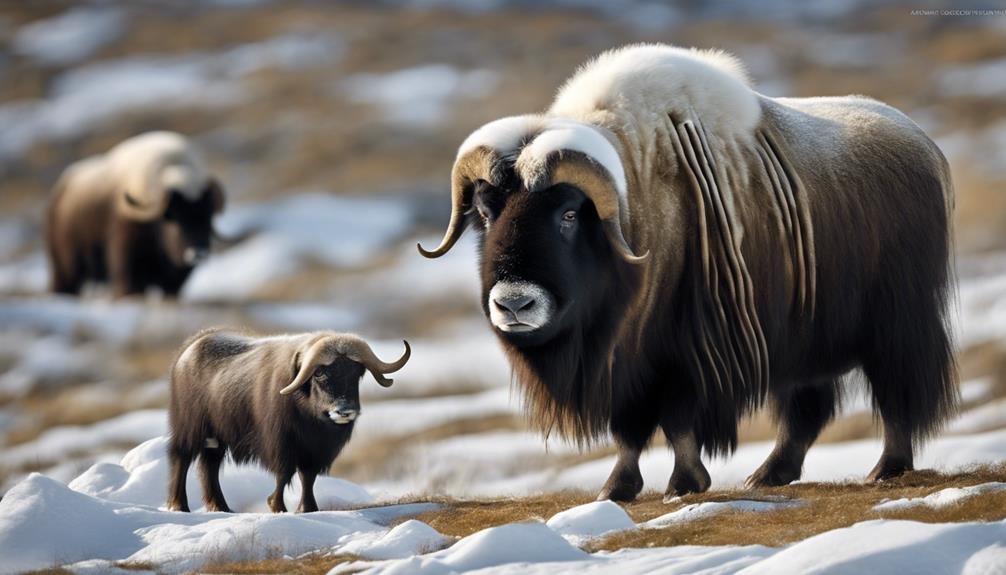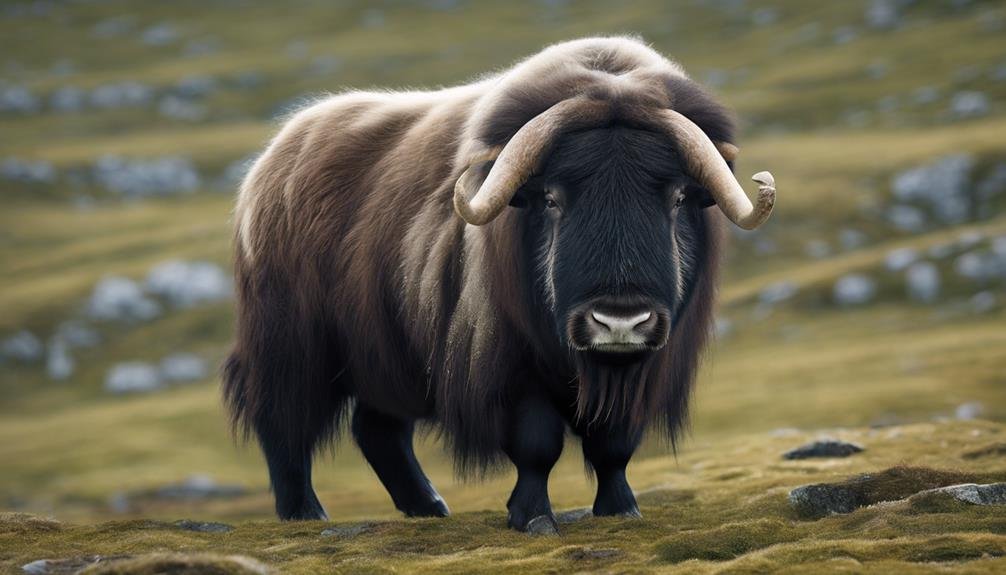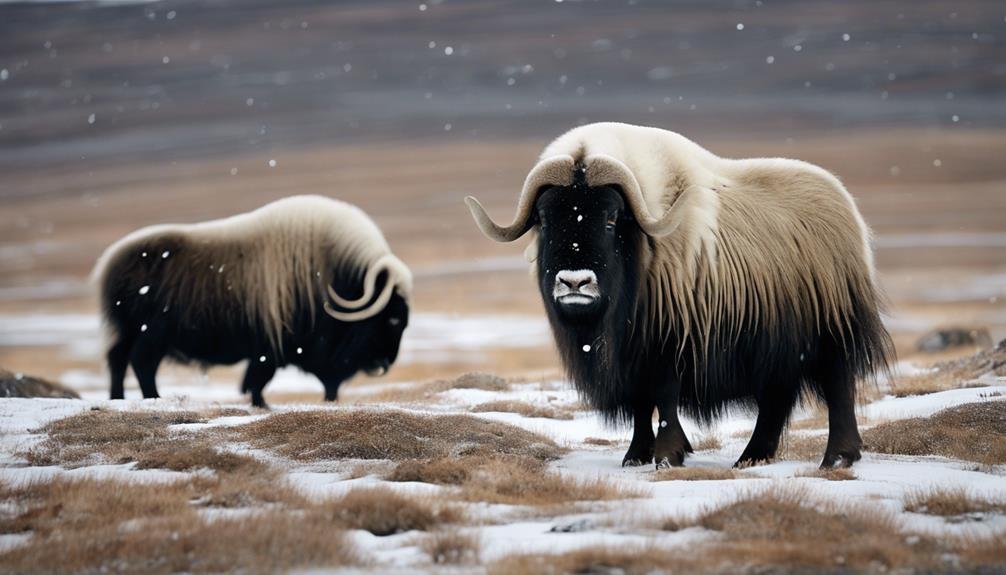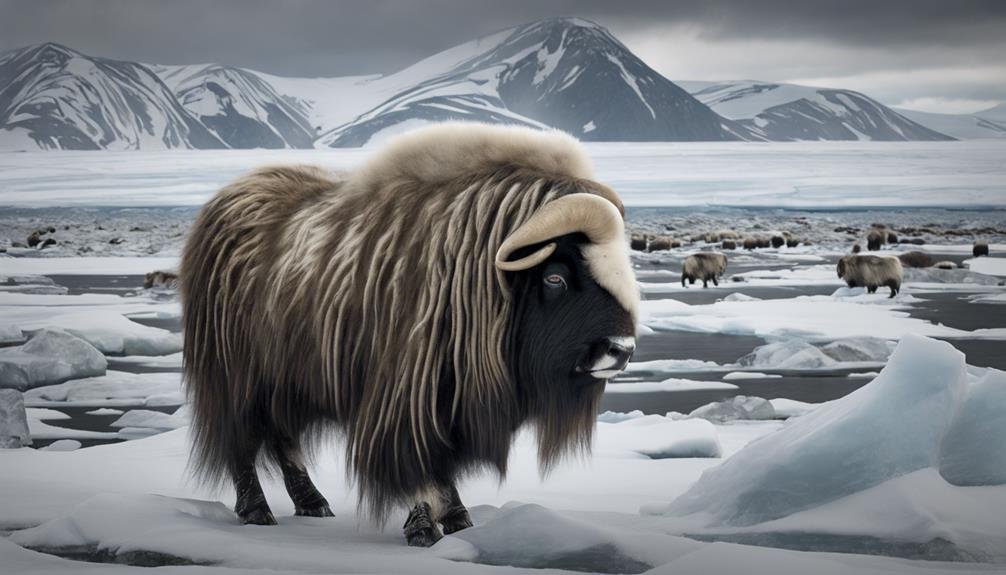Can musk oxen survive the challenges of a changing world?
Musk oxen, with their prehistoric appearance and modern presence, embody a unique blend of ancient resilience and contemporary vulnerability. How do these majestic creatures navigate the harsh Arctic tundra with their complex social structure that prioritizes collective defence against predators?
Despite their remarkable behavioural adaptations, the musk ox’s survival is increasingly threatened by climate change and human activities. This delicate balance between adaptation and vulnerability raises crucial conservation questions.
Let’s explore how these magnificent animals cope with the challenges of a changing world, emphasizing the importance of informed conservation efforts.
Key Takeaways
Key Takeaways:
- The musk ox is a fascinating Arctic species known for its intricate social behaviours and specialized foraging strategies that enable it to thrive in harsh environments.
- Musk oxen are facing significant threats from climate change, habitat loss, and human activities, highlighting the urgent need for conservation efforts to protect these magnificent creatures.
- Safeguarding the future of musk oxen requires a deep understanding of their ecology and behaviour, emphasizing the importance of conservation initiatives to preserve Arctic biodiversity.
- By protecting musk oxen, we not only ensure the survival of a crucial part of Arctic wildlife but also maintain the ecological balance of their habitats for future generations.
Introduction to Musk Ox
Survival Adaptations of Musk Ox in the Arctic
Unique Adaptations for Arctic Survival
The musk ox, a resilient inhabitant of the Arctic tundra, has evolved unique adaptations to thrive in extreme cold environments. From their diet to physical features, each aspect of the musk ox showcases remarkable strategies for surviving in the harsh Arctic landscape.
Foraging Adaptations in Deep Snow
One of the key adaptations of musk oxen is their ability to forage for Arctic tundra plants even through deep snow. This resilience allows them to find sustenance in challenging conditions, showcasing their remarkable survival instincts.
Importance of Thick Coat for Insulation
The thick coat of the musk ox serves as a crucial adaptation against brutal Arctic temperatures. This insulation provides them with the necessary protection to withstand the icy climate, highlighting the significance of their physical attributes in their survival.
Conservation Efforts and Habitat Preservation
Conservation efforts for musk ox focus on protecting their natural habitats and mitigating threats to ensure their survival. Preserving the Arctic landscape is essential for the continued existence of these vital Arctic wildlife members, emphasizing the importance of conservation initiatives.
Foundational Role of Diet in Survival
The diet of musk oxen, consisting primarily of Arctic tundra plants, is foundational to their existence in the unforgiving Arctic environment. Their ability to find and consume these plants is essential for their survival, highlighting the importance of their dietary adaptations.
Behavioural and Social Structure for Survival
While physical adaptations and diet are crucial, musk ox behaviour and social structure also play significant roles in their survival. Their interactions within herds and behavioural patterns contribute to their resilience in the Arctic tundra, showcasing the complexity of their survival strategies.
Behaviour and Social Structure

Social Structure and Mating Rituals
Musk ox herds, consisting of females and their young, showcase intricate mating rituals that promote genetic diversity within the species. These rituals are crucial for the survival of musk oxen in the harsh Arctic conditions. The social cohesion within the herds also serves as a defence mechanism against predators like polar bears.
Challenges and Impacts
Threats such as climate change and human activities have led to fluctuations in musk ox population trends. Understanding the behaviour of musk oxen is essential in addressing these challenges and ensuring their continued survival in the Arctic tundra.
Indigenous Practices and Sustainable Coexistence
Indigenous communities have long respected the ecological role of musk oxen while utilising their resources in a sustainable manner. This approach offers valuable insights into maintaining a harmonious balance between musk oxen and their environment, showcasing the importance of coexistence and conservation efforts.
Diet and Foraging Habits

Foraging Strategies
Musk oxen in the Arctic have developed unique foraging strategies to survive in their extreme habitat. They primarily feed on tundra grasses, mosses, and Arctic willows, adapting their diets to the seasonal variations. These adaptations are crucial for their survival, especially as climate change impacts their food sources. The ability to adjust their foraging habits showcases the resilience of musk oxen in the face of harsh environmental conditions.
Qiviut Wool
One fascinating aspect of musk oxen is their qiviut wool, a highly insulating fibre that they shed to stay warm in the cold Arctic climate. This wool not only benefits the animals but also humans who collect and use it for various purposes. The qiviut wool is a valuable resource that highlights the unique relationship between musk oxen and their environment, showcasing the intricate balance of nature in the Arctic.
Adaptation in Baby Musk Oxen
Baby musk oxen must quickly adapt to the varied diet and foraging habits of their species for their survival. Learning to navigate the challenges of finding and consuming the right food is essential for their growth and development. These young musk oxen demonstrate remarkable resilience as they learn to thrive in their harsh environment, relying on their instincts and learning from the adults in their herd.
Observing Musk Oxen
For those interested in observing musk oxen in their natural habitat, musk ox tours in the Arctic offer a unique opportunity to witness these animals up close. These tours provide insights into the foraging habits of musk oxen and the incredible adaptations they’ve developed to survive in the Arctic. By observing these majestic creatures in the wild, visitors can gain a deeper appreciation for the resilience and beauty of musk oxen in their natural environment.
Conservation Status and Threats

Conservation Status and Threats
Impacts of Climate Change
The shifting climate in the Arctic poses a significant threat to musk oxen. As temperatures rise, the delicate balance of their ecosystems is disrupted, affecting the availability of food and suitable habitats. This forces musk oxen to adapt to new challenges, putting their populations at risk.
Human Encroachment and Exploitation
Human activities, including the harvesting of musk ox wool, contribute to the pressure on these majestic creatures. While the demand for their wool brings economic benefits to local communities, unsustainable harvesting practices can lead to overexploitation. It’s crucial to find a balance that ensures the well-being of musk oxen while supporting the livelihoods of those who rely on their resources.
Conservation Efforts
Conservation efforts play a vital role in safeguarding musk oxen and their habitats. By implementing measures to protect these iconic animals and their ecosystems, we can help ensure their survival for generations to come. Collaborative initiatives involving local communities, researchers, and policymakers are essential in preserving the unique biodiversity of the Arctic and securing the future of musk oxen.
Conservation Status and Threats

Critical Threats to Musk Oxen Conservation
1. Climate Change Impact:
Rising temperatures in the Arctic disrupt the delicate balance of the ecosystem, affecting the availability of food for musk oxen and altering their breeding patterns. These changes pose a significant threat to the survival of these iconic creatures.
2. Human Encroachment and Habitat Loss:
The expansion of human activities encroaches on musk oxen habitats, forcing them into shrinking and marginal areas. This loss of habitat limits their ability to find food, seek shelter, and maintain their natural way of life.
3. Illegal Exploitation and Overharvesting:
The illegal hunting and overharvesting of musk oxen for their valuable fur and meat further endanger their populations. This unsustainable exploitation undermines conservation efforts and puts additional pressure on already vulnerable herds.
4. Disease Transmission and Predation Risk:
Increased contact with domestic animals can introduce new diseases to musk oxen populations, weakening their health and resilience. Additionally, changes in predator-prey dynamics due to environmental shifts can pose new risks to musk oxen survival.
These key threats highlight the urgent need for comprehensive conservation strategies to safeguard the future of musk oxen and ensure their continued presence in the Arctic ecosystem.
What is the relationship between musk oxen and Greenland sharks in their natural habitat?
In the natural habitat, musk oxen and Greenland sharks have an interesting relationship. Musk oxen are known to be prey for Greenland sharks, which lurk in the cold waters. In turn, when these sharks die, their bodies provide sustenance for musk oxen, contributing to the delicate balance of the ecosystem. Interesting facts about Greenland sharks indeed.
Frequently Asked Questions
How Does the Musk Ox’s Wool, Qiviut, Compare in Warmth and Softness to Other Animal Fibers Like Merino Wool or Cashmere?
Q: What makes qiviut stand out in terms of warmth and softness compared to merino wool and cashmere?
A: Qiviut, the musk ox’s undercoat, excels in warmth and softness due to its finer fibres. It provides superior insulation while being lighter and less itchy than other animal fibres like merino wool and cashmere.
What Are the Historical and Cultural Significances of Musk Oxen to Indigenous Peoples of the Arctic Regions?
Q: Why do Indigenous peoples of the Arctic regions value musk oxen?
A: Indigenous peoples of the Arctic regions value musk oxen for their qiviut, a fibre that is warmer and softer than others. They hold cultural significance in spiritual beliefs, clothing, and aiding survival in harsh climates.
How Do Musk Oxen Cope With Insect Pests During the Warmer Months?
Q: How do musk oxen protect themselves from insect pests during the warmer months?
A: Musk oxen rely on their thick fur to shield themselves from insect pests. They often roll in dirt or snow to dislodge the pests and seek out windy areas to avoid them.
Can Musk Oxen Be Domesticated for Agricultural or Other Human Uses, Similar to Other Large Mammals?
Q: Can Musk Oxen be domesticated for agricultural purposes like wool production?
A: Yes, Musk Oxen can be domesticated for wool production due to their adaptability and social behaviour, making them suitable for agriculture.
What Are the Main Differences in Physical Appearance and Size Between Male and Female Musk Oxen?
Q: What are the main differences in physical appearance and size between male and female musk oxen?
A: Male musk oxen are larger with more massive horns, thicker necks, and broader shoulders. In contrast, females have a smaller build, less pronounced horn curvature, and exhibit sexual dimorphism in the species.
How Do Musk Oxen and Puffins Adapt to Harsh Arctic Environments?
Musk oxen have thick, multi-layered fur that insulates them from the extreme cold, while puffins also thrive in harsh Arctic climates. Among interesting puffin bird facts is their ability to swim underwater using their wings, allowing them to catch fish with expertise despite the freezing temperatures.
How Do Musk Oxen and Ringed Seals Adapt to Extreme Arctic Conditions?
Musk oxen have thick, double-layered fur to retain heat, while ringed seals rely on a heavy layer of blubber for insulation in icy waters. These adaptations are essential for survival in the Arctic’s harsh climate. For more detailed ringed seal information, understanding their diving abilities and breeding patterns is crucial.
How Do Musk Oxen and Arctic Foxes Adapt to Survive in Harsh Arctic Conditions?
Musk oxen have thick, insulating fur and a compact body shape to conserve heat, while they migrate seasonally to find food. Arctic fox adaptations include a multi-layered coat for warmth, small ears to minimize heat loss, and impressive hunting skills to scavenge leftovers from larger predators like polar bears and wolves.
Conclusion
In summary, the musk ox is a fascinating Arctic species known for its intricate social behaviours and specialized foraging strategies that help it thrive in harsh environments.
Despite their resilience, these magnificent creatures are facing significant threats from climate change, habitat loss, and human activities.
Conservation efforts are vital in safeguarding the future of musk oxen, requiring a deep understanding of their ecology and behaviour.
By protecting musk oxen, we not only preserve an essential part of Arctic biodiversity but also maintain the ecological balance of their habitats for generations to come.


